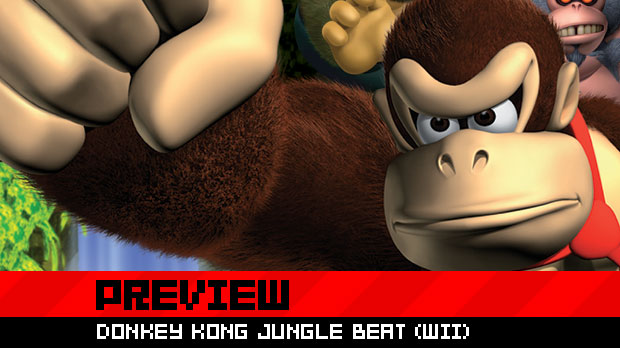Late in the GameCube’s life cycle, Donkey Kong Jungle Beat was released for Nintendo’s little purple box. A platformer starring the big ape, its biggest draw was the fact that to controlling DK used the bongos peripheral, previously only useful for Donkey Konga. As someone who played Donkey Konga to the extreme and loved the GameCube, I say with regret that I never played Donkey Kong Jungle Beat more than a few demo sessions at Best Buy.
Which is a drag, considering Donkey Kong Jungle Beat is widely considered a fantastic game. It used the bongos in a unique and fun manner, with only the shortness of the game, the premium price to play it (you needed the bongos), and the small GameCube marketshare holding Donkey Kong Jungle Beat back from being a more popular game. I mean, the team that made this game transitioned to Super Mario Galaxy, so you know the pedigree is pretty great.
Thus, it is pretty interesting how Nintendo has remade the game under the New Play Control! series. I can definitely say it is an interesting twist on the original game and, surprisingly, Nintendo has toned down on the innovated controls seen in the original game. While not a bad thing, you’ll have to hit the jump to find out what I mean.
Donkey Kong Jungle Beat (Wii)
Developer: Nintendo
Publisher: Nintendo
To be released: May 4, 2009
Here’s the deal: there’s not much that gets more unique and special than a platformer that uses bongos to control. So with the New Play Control! version of Donkey Kong Jungle Beat missing bongos, Nintendo has decided give DK more traditional controls. Instead of tapping the drums left and right to go left and right, you use the nunchuk’s control stick to make DK move around. Jumping is now a tap of the A button, and attacks now come from a shake of either nunchuck or Wiimote. This clap attack is a little different now, too. Instead of just doing a circular attack, you can now direct the motion of the shockwave. Jumping, then tapping B will grant a ground pound.
Honestly, I feel surprisingly weird about this control scheme. I really loved playing with the bongos, and switching to a standard platformer control style is… different. Coming from Nintendo, it’s a little surprising that they would choose to do this. Sure, it didn’t take me long to adjust and, thankfully, this play style gives DK even more finesse to move around, so I don’t think it is really awful. Like I said, it’s different.
Anyone who played the original might be a little unsettled by this news, but I can bet that this style might actually attract more players. Traditional gamers might like the more traditional platforming controls; new gamers might find the melding of Wii motion controls to platforming controls a segueing factor to more traditional games. And the fact that game will only sell for $29.99, lacks expensive peripherals, and comes to the large Wii market, Nintendo will probably sell more of this game than the original.

Thankfully, since Donkey Kong Jungle Beat has tighter controls and is a rerelease, Nintendo has added new stuff to make the game a better fit for the Wii. First of all, there are new objects and enemies to interact with, and these certainly make use of the Wii’s capabilities. Seeds need you to pummel the ground before they sprout up some score-boosting bananas, barrels and sling-shot plants will require you to shake before shooting off, and enemies and the seven bosses will require you to punch just like DK to make them pop.
One charming boss battle against Dred Kong actually plays out like somethign you’d see in Punch Out!!, which is pretty fun. New end-level bonuses will force you shake your remotes, and even a side-scrolling race away from an avalanche ends with a ski-jump that requires you to shake to set a jump record. It’s all small, context-based uses of the Wii motion controls, and it’s fun. So while the controls are more traditional, there is plenty of stuff that is not.
Now the goal of Donkey Kong Jungle beat is really to get as many bananas as possible. They’re littered all over the levels, and if you get enough, you get crests which unlock more levels. As far as levels go, there are four worlds to play in, with three stages to the world and three parts per stage. While not a ton, each level encourages replay, especially when you take the combo system into account.

If you can attack, jump, wall-bounce, and generally play Donkey Kong Jungle Beat really well, your combo meter will rise, and when you collect bananas, they will multiply. So if you get a combo of six going, and you collect a banana without touching the ground or getting hit, each banana will be worth six instead of one. This is great — and requires skill — for when you are trying to get the highest level crest and unlock new levels.
Interestingly, if you have trouble finding the best areas to get the highest combo scores, at the end of areas a video will pop up showing where the best areas to go to are. Most hardcore gamers won’t need this, but new gamers should appreciate the help.
It really seems like Nintendo is trying to make this game a good deal for consumers. For most people who never played the original, the lack of bongo controls should not be a problem, and the new stuff added to the game should help lengthen the acknowledged brevity of Donkey Kong Jungle Beat.
It also helps that the game is only 30 bucks, which is great for recession-stricken gamers. I’m still a big fan of the bongo original, but hopefully this remake should find new lease for Donkey Kong Jungle Beat.


